Abstract
Lymphocytes migrate from blood into lymph nodes (LN) of rats specifically at segments of venules lined by high endothelium (HEV). We have previously shown that pretreatment of LN HEV cells with pro-inflammatory cytokines such as tumour necrosis factor-alpha (TNF-alpha) and interferon-gamma (IFN-gamma), augments their adhesiveness for thoracic duct lymphocytes (TDL). Here we report that a mouse monoclonal antibody, 3C10, recognized tissue-specific endothelial determinants on rat LN HEV cells and blocked their adhesiveness for TDL and EL-4J cells transfected with rat L-selectin. In contrast, 3C10 antibody did not inhibit lymphocyte attachment to Peyer's patch (PP) frozen sections or cultured PP HEV cells. The antibody immunoprecipitated from LN HEV cells two proteins with apparent molecular weights of 90,000 and 50,000. The expression of 3C10 antigen on LN HEV cells was increased by incubation with TNF-alpha or IFN-gamma. Furthermore, pretreatment of cytokine-stimulated LN HEV cells with 3C10 antibody blocked TDL binding in a dose-dependent manner. In contrast, 3C10 antigen expression on LN HEV cells was significantly decreased following incubation of cells with transforming growth factor-beta 1 (TGF-beta 1). In addition, TGF-beta 1 also abrogated the adhesiveness of LN HEV cells stimulated with TNF-alpha, IFN-gamma or both cytokines. Together, these data suggest that endothelial determinants recognized by the 3C10 antibody are tissue-specific ligands for lymphocyte adhesion and cytokines such as TNF-alpha and TGF-beta differentially regulate their expression and function.
Full text
PDF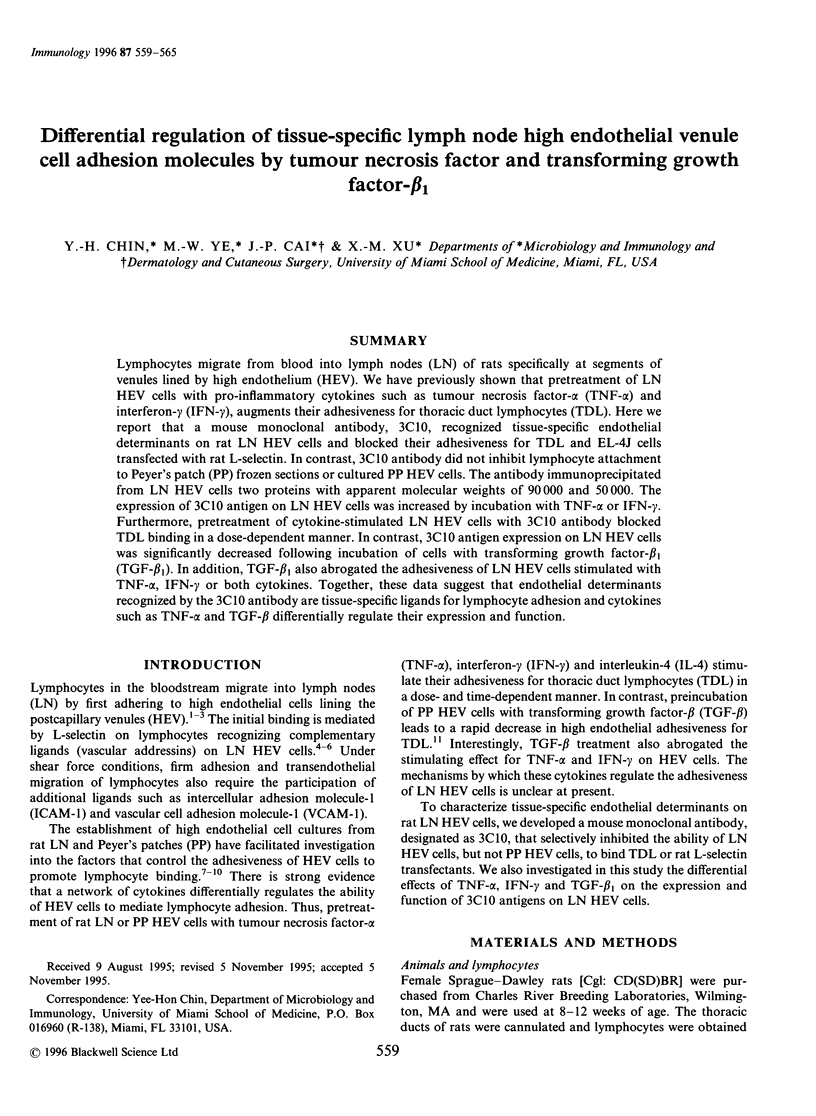
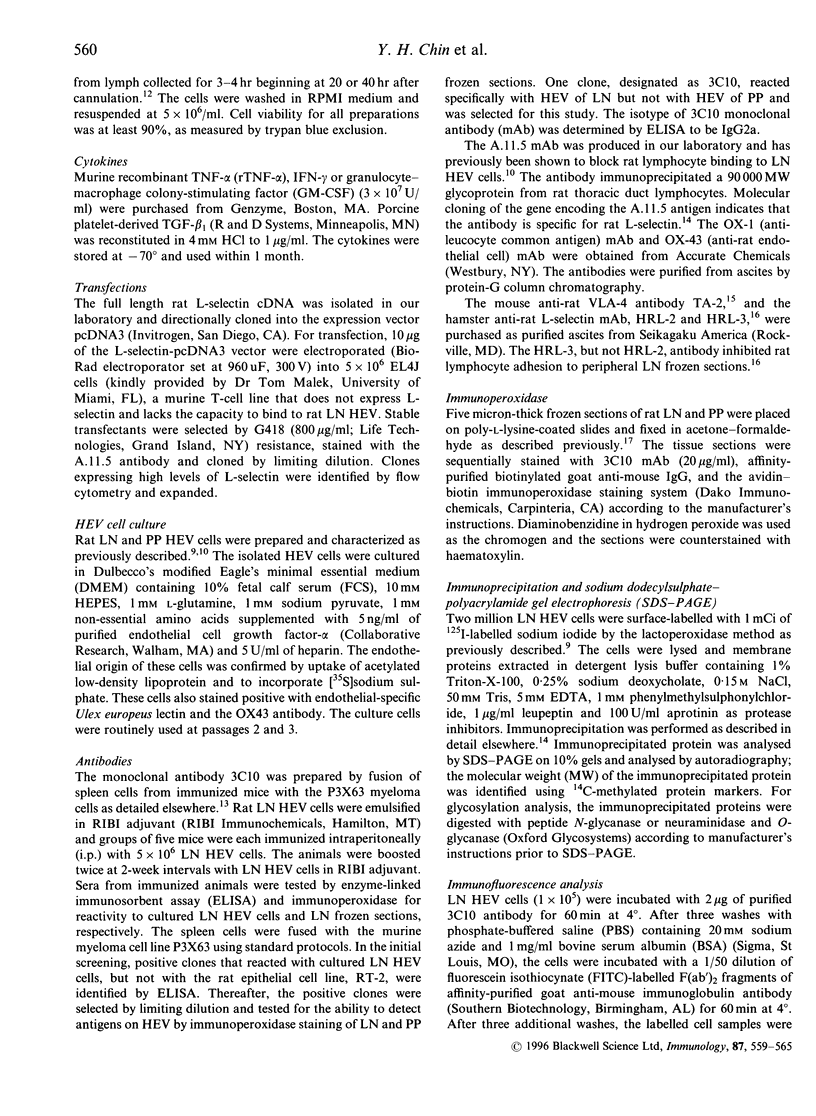
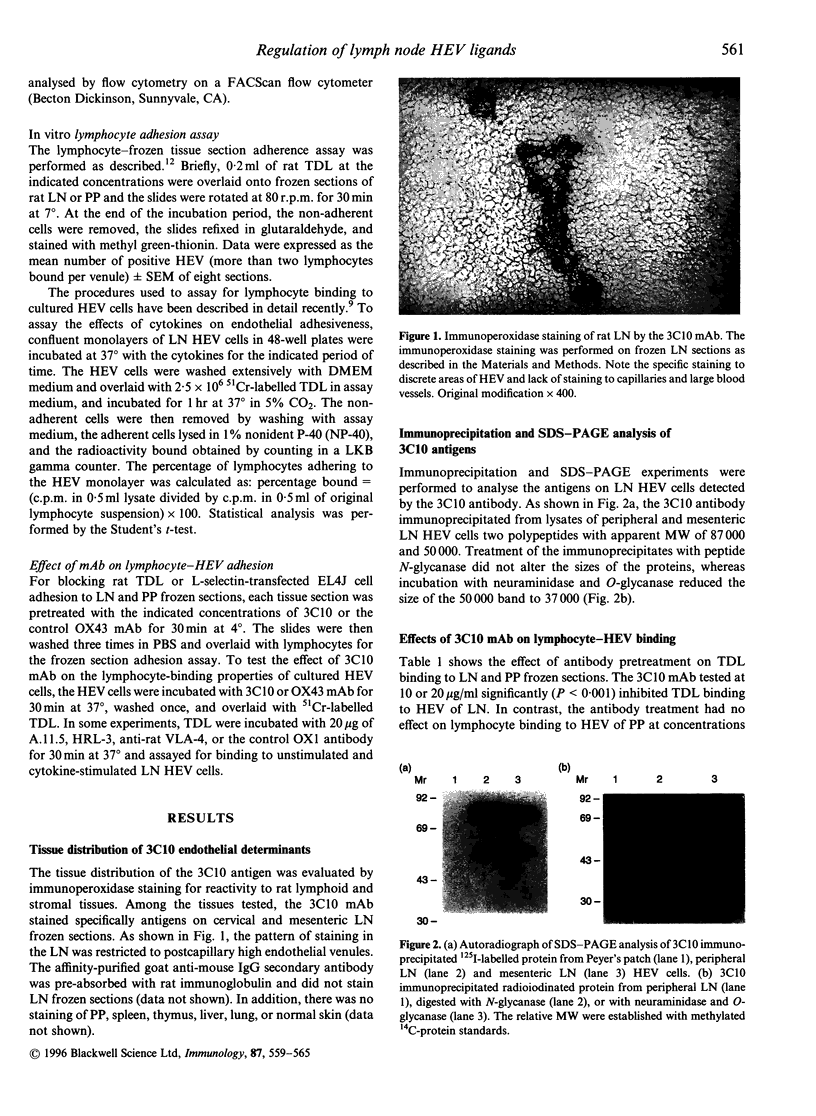
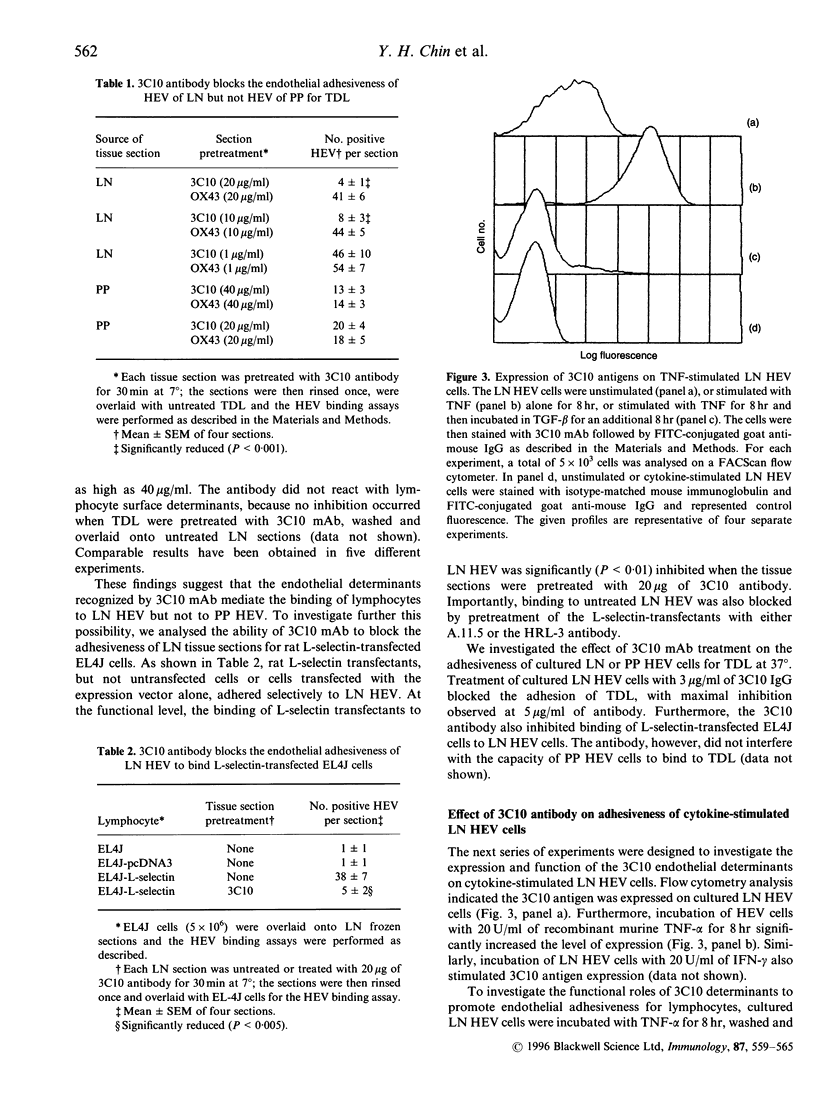
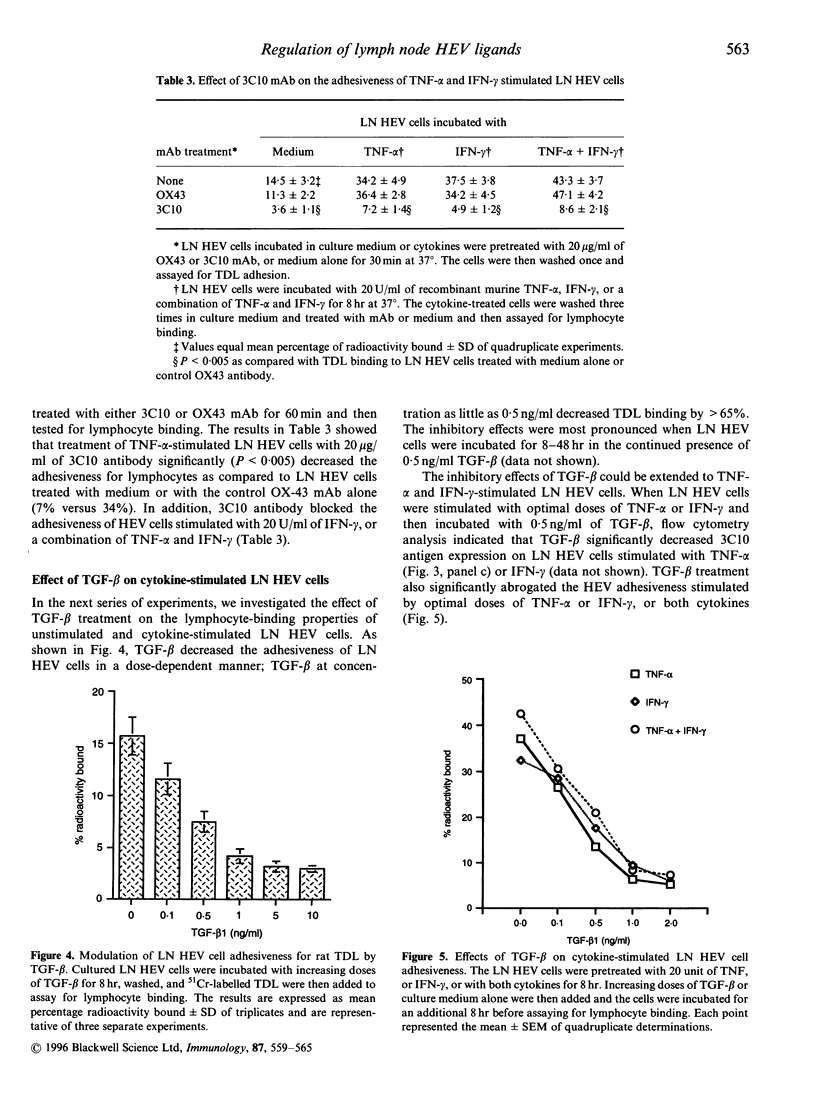
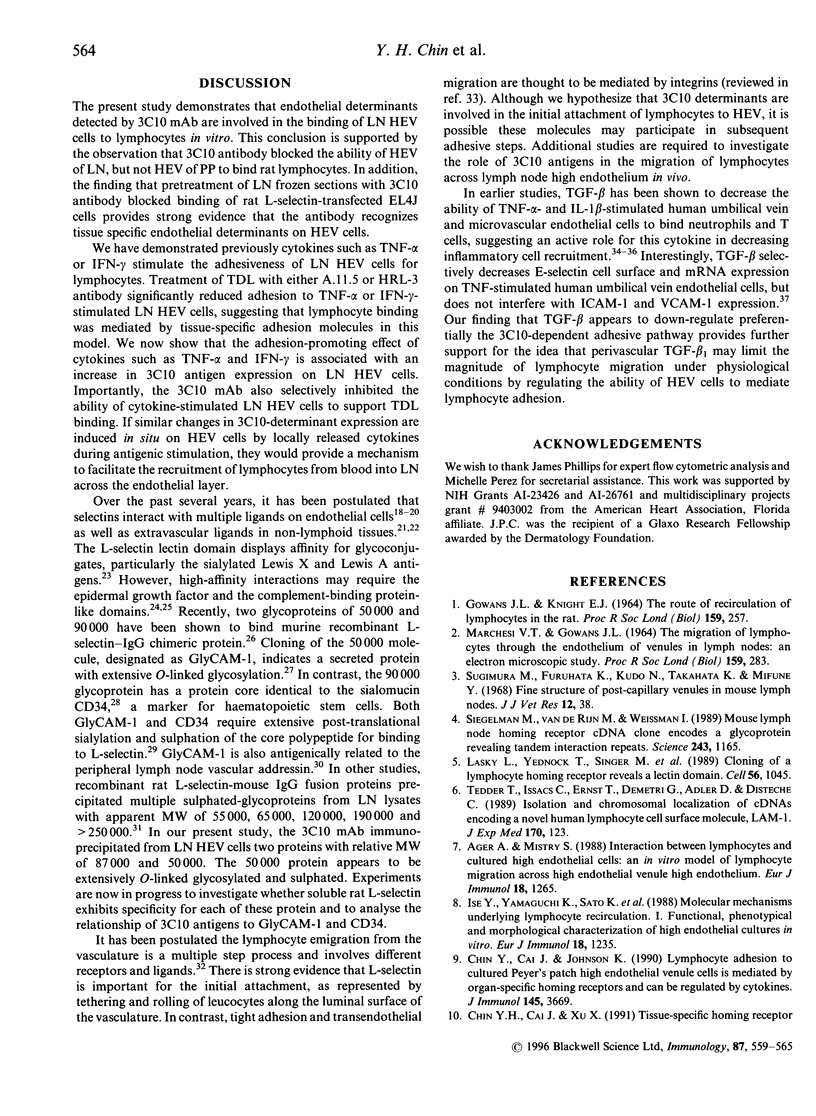
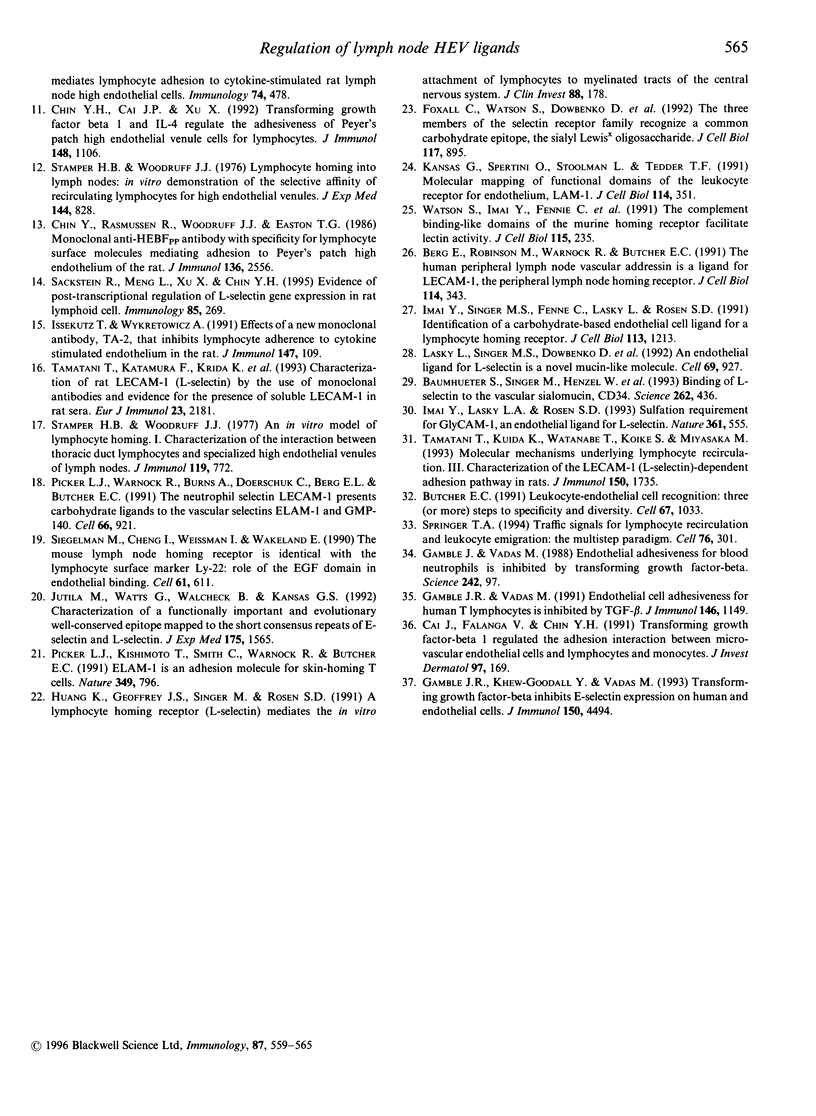
Images in this article
Selected References
These references are in PubMed. This may not be the complete list of references from this article.
- Ager A., Mistry S. Interaction between lymphocytes and cultured high endothelial cells: an in vitro model of lymphocyte migration across high endothelial venule endothelium. Eur J Immunol. 1988 Aug;18(8):1265–1274. doi: 10.1002/eji.1830180818. [DOI] [PubMed] [Google Scholar]
- Baumheter S., Singer M. S., Henzel W., Hemmerich S., Renz M., Rosen S. D., Lasky L. A. Binding of L-selectin to the vascular sialomucin CD34. Science. 1993 Oct 15;262(5132):436–438. doi: 10.1126/science.7692600. [DOI] [PubMed] [Google Scholar]
- Berg E. L., Robinson M. K., Warnock R. A., Butcher E. C. The human peripheral lymph node vascular addressin is a ligand for LECAM-1, the peripheral lymph node homing receptor. J Cell Biol. 1991 Jul;114(2):343–349. doi: 10.1083/jcb.114.2.343. [DOI] [PMC free article] [PubMed] [Google Scholar]
- Butcher E. C. Leukocyte-endothelial cell recognition: three (or more) steps to specificity and diversity. Cell. 1991 Dec 20;67(6):1033–1036. doi: 10.1016/0092-8674(91)90279-8. [DOI] [PubMed] [Google Scholar]
- Cai J. P., Falanga V., Chin Y. H. Transforming growth factor-beta regulates the adhesive interactions between mononuclear cells and microvascular endothelium. J Invest Dermatol. 1991 Aug;97(2):169–174. doi: 10.1111/1523-1747.ep12479498. [DOI] [PubMed] [Google Scholar]
- Chin Y. H., Cai J. P., Johnson K. Lymphocyte adhesion to cultured Peyer's patch high endothelial venule cells is mediated by organ-specific homing receptors and can be regulated by cytokines. J Immunol. 1990 Dec 1;145(11):3669–3677. [PubMed] [Google Scholar]
- Chin Y. H., Cai J. P., Xu X. M. Transforming growth factor-beta 1 and IL-4 regulate the adhesiveness of Peyer's patch high endothelial venule cells for lymphocytes. J Immunol. 1992 Feb 15;148(4):1106–1112. [PubMed] [Google Scholar]
- Chin Y. H., Rasmussen R. A., Woodruff J. J., Easton T. G. A monoclonal anti-HEBFPP antibody with specificity for lymphocyte surface molecules mediating adhesion to Peyer's patch high endothelium of the rat. J Immunol. 1986 Apr 1;136(7):2556–2561. [PubMed] [Google Scholar]
- Foxall C., Watson S. R., Dowbenko D., Fennie C., Lasky L. A., Kiso M., Hasegawa A., Asa D., Brandley B. K. The three members of the selectin receptor family recognize a common carbohydrate epitope, the sialyl Lewis(x) oligosaccharide. J Cell Biol. 1992 May;117(4):895–902. doi: 10.1083/jcb.117.4.895. [DOI] [PMC free article] [PubMed] [Google Scholar]
- GOWANS J. L., KNIGHT E. J. THE ROUTE OF RE-CIRCULATION OF LYMPHOCYTES IN THE RAT. Proc R Soc Lond B Biol Sci. 1964 Jan 14;159:257–282. doi: 10.1098/rspb.1964.0001. [DOI] [PubMed] [Google Scholar]
- Gamble J. R., Khew-Goodall Y., Vadas M. A. Transforming growth factor-beta inhibits E-selectin expression on human endothelial cells. J Immunol. 1993 May 15;150(10):4494–4503. [PubMed] [Google Scholar]
- Gamble J. R., Vadas M. A. Endothelial adhesiveness for blood neutrophils is inhibited by transforming growth factor-beta. Science. 1988 Oct 7;242(4875):97–99. doi: 10.1126/science.3175638. [DOI] [PubMed] [Google Scholar]
- Gamble J. R., Vadas M. A. Endothelial cell adhesiveness for human T lymphocytes is inhibited by transforming growth factor-beta 1. J Immunol. 1991 Feb 15;146(4):1149–1154. [PubMed] [Google Scholar]
- Imai Y., Lasky L. A., Rosen S. D. Sulphation requirement for GlyCAM-1, an endothelial ligand for L-selectin. Nature. 1993 Feb 11;361(6412):555–557. doi: 10.1038/361555a0. [DOI] [PubMed] [Google Scholar]
- Imai Y., Singer M. S., Fennie C., Lasky L. A., Rosen S. D. Identification of a carbohydrate-based endothelial ligand for a lymphocyte homing receptor. J Cell Biol. 1991 Jun;113(5):1213–1221. doi: 10.1083/jcb.113.5.1213. [DOI] [PMC free article] [PubMed] [Google Scholar]
- Ise Y., Yamaguchi K., Sato K., Yamamura Y., Kitamura F., Tamatani T., Miyasaka M. Molecular mechanisms underlying lymphocyte recirculation. I. Functional, phenotypical and morphological characterization of high endothelial cells cultured in vitro. Eur J Immunol. 1988 Aug;18(8):1235–1244. doi: 10.1002/eji.1830180814. [DOI] [PubMed] [Google Scholar]
- Issekutz T. B., Wykretowicz A. Effect of a new monoclonal antibody, TA-2, that inhibits lymphocyte adherence to cytokine stimulated endothelium in the rat. J Immunol. 1991 Jul 1;147(1):109–116. [PubMed] [Google Scholar]
- Jutila M. A., Watts G., Walcheck B., Kansas G. S. Characterization of a functionally important and evolutionarily well-conserved epitope mapped to the short consensus repeats of E-selectin and L-selectin. J Exp Med. 1992 Jun 1;175(6):1565–1573. doi: 10.1084/jem.175.6.1565. [DOI] [PMC free article] [PubMed] [Google Scholar]
- Kansas G. S., Spertini O., Stoolman L. M., Tedder T. F. Molecular mapping of functional domains of the leukocyte receptor for endothelium, LAM-1. J Cell Biol. 1991 Jul;114(2):351–358. doi: 10.1083/jcb.114.2.351. [DOI] [PMC free article] [PubMed] [Google Scholar]
- Lasky L. A., Singer M. S., Dowbenko D., Imai Y., Henzel W. J., Grimley C., Fennie C., Gillett N., Watson S. R., Rosen S. D. An endothelial ligand for L-selectin is a novel mucin-like molecule. Cell. 1992 Jun 12;69(6):927–938. doi: 10.1016/0092-8674(92)90612-g. [DOI] [PubMed] [Google Scholar]
- Lasky L. A., Singer M. S., Yednock T. A., Dowbenko D., Fennie C., Rodriguez H., Nguyen T., Stachel S., Rosen S. D. Cloning of a lymphocyte homing receptor reveals a lectin domain. Cell. 1989 Mar 24;56(6):1045–1055. doi: 10.1016/0092-8674(89)90637-5. [DOI] [PubMed] [Google Scholar]
- MARCHESI V. T., GOWANS J. L. THE MIGRATION OF LYMPHOCYTES THROUGH THE ENDOTHELIUM OF VENULES IN LYMPH NODES: AN ELECTRON MICROSCOPE STUDY. Proc R Soc Lond B Biol Sci. 1964 Jan 14;159:283–290. doi: 10.1098/rspb.1964.0002. [DOI] [PubMed] [Google Scholar]
- Picker L. J., Kishimoto T. K., Smith C. W., Warnock R. A., Butcher E. C. ELAM-1 is an adhesion molecule for skin-homing T cells. Nature. 1991 Feb 28;349(6312):796–799. doi: 10.1038/349796a0. [DOI] [PubMed] [Google Scholar]
- Picker L. J., Warnock R. A., Burns A. R., Doerschuk C. M., Berg E. L., Butcher E. C. The neutrophil selectin LECAM-1 presents carbohydrate ligands to the vascular selectins ELAM-1 and GMP-140. Cell. 1991 Sep 6;66(5):921–933. doi: 10.1016/0092-8674(91)90438-5. [DOI] [PubMed] [Google Scholar]
- Siegelman M. H., Cheng I. C., Weissman I. L., Wakeland E. K. The mouse lymph node homing receptor is identical with the lymphocyte cell surface marker Ly-22: role of the EGF domain in endothelial binding. Cell. 1990 May 18;61(4):611–622. doi: 10.1016/0092-8674(90)90473-r. [DOI] [PubMed] [Google Scholar]
- Siegelman M. H., van de Rijn M., Weissman I. L. Mouse lymph node homing receptor cDNA clone encodes a glycoprotein revealing tandem interaction domains. Science. 1989 Mar 3;243(4895):1165–1172. doi: 10.1126/science.2646713. [DOI] [PubMed] [Google Scholar]
- Springer T. A. Traffic signals for lymphocyte recirculation and leukocyte emigration: the multistep paradigm. Cell. 1994 Jan 28;76(2):301–314. doi: 10.1016/0092-8674(94)90337-9. [DOI] [PubMed] [Google Scholar]
- Stamper H. B., Jr, Woodruff J. J. An in vitro model of lymphocyte homing. I. Characterization of the interaction between thoracic duct lymphocytes and specialized high-endothelial venules of lymph nodes. J Immunol. 1977 Aug;119(2):772–780. [PubMed] [Google Scholar]
- Stamper H. B., Jr, Woodruff J. J. Lymphocyte homing into lymph nodes: in vitro demonstration of the selective affinity of recirculating lymphocytes for high-endothelial venules. J Exp Med. 1976 Sep 1;144(3):828–833. doi: 10.1084/jem.144.3.828. [DOI] [PMC free article] [PubMed] [Google Scholar]
- Tamatani T., Kitamura F., Kuida K., Shirao M., Mochizuki M., Suematsu M., Schmid-Schönbein G. W., Watanabe K., Tsurufuji S., Miyasaka M. Characterization of rat LECAM-1 (L-selectin) by the use of monoclonal antibodies and evidence for the presence of soluble LECAM-1 in rat sera. Eur J Immunol. 1993 Sep;23(9):2181–2188. doi: 10.1002/eji.1830230920. [DOI] [PubMed] [Google Scholar]
- Tamatani T., Kuida K., Watanabe T., Koike S., Miyasaka M. Molecular mechanisms underlying lymphocyte recirculation. III. Characterization of the LECAM-1 (L-selectin)-dependent adhesion pathway in rats. J Immunol. 1993 Mar 1;150(5):1735–1745. [PubMed] [Google Scholar]
- Tedder T. F., Isaacs C. M., Ernst T. J., Demetri G. D., Adler D. A., Disteche C. M. Isolation and chromosomal localization of cDNAs encoding a novel human lymphocyte cell surface molecule, LAM-1. Homology with the mouse lymphocyte homing receptor and other human adhesion proteins. J Exp Med. 1989 Jul 1;170(1):123–133. doi: 10.1084/jem.170.1.123. [DOI] [PMC free article] [PubMed] [Google Scholar]
- Watson S. R., Imai Y., Fennie C., Geoffrey J., Singer M., Rosen S. D., Lasky L. A. The complement binding-like domains of the murine homing receptor facilitate lectin activity. J Cell Biol. 1991 Oct;115(1):235–243. doi: 10.1083/jcb.115.1.235. [DOI] [PMC free article] [PubMed] [Google Scholar]




